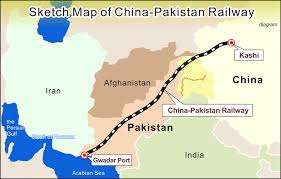What’s Next for the China-Pakistan Economic Corridor?
|
Getting your Trinity Audio player ready...
|
The China-Pakistan Economic Corridor (CPEC) is a big project that has changed the way Pakistan and China work together. It’s part of China’s Belt and Road Initiative (BRI), which aims to connect countries through roads, railways, ports, and other infrastructure. CPEC is like a bridge that links Pakistan’s Gwadar Port in Balochistan to China’s Xinjiang region, covering about 3,000 kilometers. This project is not just about building roads or power plants; it’s about creating jobs, improving trade, and making Pakistan’s economy stronger. For Pakistani readers, it’s important to understand what CPEC has done so far, what’s happening now, and what’s coming next. This article will explain everything in simple English, using the latest updates as of May 2025.
What is CPEC?
CPEC started in 2015 when Chinese President Xi Jinping visited Pakistan and signed agreements worth $46 billion. The goal was to build infrastructure like roads, railways, ports, and power plants to help Pakistan grow economically. At the same time, it would give China a shorter route to send its goods to Europe, Africa, and the Middle East through Pakistan’s Gwadar Port, avoiding the longer route through the Straits of Malacca.
For Pakistan, CPEC is a chance to fix problems like electricity shortages, poor roads, and a weak economy. For China, it’s a way to boost trade and secure energy supplies. The project is divided into phases, with the first phase focusing on energy and transport, and the second phase (CPEC 2.0) focusing on industry, agriculture, and green energy.
What Has CPEC Achieved So Far?
Since 2015, CPEC has made a big difference in Pakistan. Here are some key achievements:
1. Energy Projects
Pakistan used to face long power cuts, which hurt businesses and daily life. CPEC brought in power plants that added about 6,000 megawatts of electricity to the national grid. Projects like the Sahiwal Coal Power Plant, Thar Coal Block-I, and Karot Hydropower Plant have reduced load-shedding. As of 2025, Pakistan’s energy capacity is 24,830 MW, and CPEC projects have played a big role in this.
2. Transport Infrastructure
CPEC has built and improved roads and railways across Pakistan. For example:
- The Karachi-Lahore Motorway (M-9) and Multan-Sukkur Motorway (M-5) have made travel faster and safer.
- The Orange Line Metro in Lahore, a $1.6 billion project, is now fully operational. It carries 250,000 passengers daily and plans to reach 500,000 by 2025. It’s Pakistan’s first driverless metro.
- Gwadar Port is being developed to handle big ships, making it a key trade hub.
3. Gwadar Port and Airport
Gwadar is the heart of CPEC. The port is being upgraded to handle international trade, and the New Gwadar International Airport, funded by a $230 million Chinese grant, opened in 2024. It’s Pakistan’s largest airport, with a 3.6-kilometer runway that can handle big planes like Boeing and Airbus. However, it’s not fully operational yet due to security and scheduling issues.
4. Jobs and Economic Growth
CPEC has created thousands of jobs for Pakistanis, especially in construction and energy. It’s also helped increase Pakistan’s exports by about 4.5% annually until 2025, according to some reports. The project has attracted $25.4 billion in direct investment from China.
5. Special Economic Zones (SEZs)
SEZs are areas where businesses get tax breaks and other benefits to set up factories. The Rashakai SEZ in Khyber Pakhtunkhwa and Allama Iqbal Industrial City in Faisalabad are examples. These zones aim to boost manufacturing and create more jobs.
What’s Happening Now? Latest Updates in 2025
As of May 2025, CPEC is moving into its second phase, called CPEC 2.0. This phase is about building industries, improving agriculture, and focusing on green energy. Here are the latest updates:
1. CPEC 2.0 Launched
In January 2025, Pakistan and China agreed to start the second phase of CPEC. This was decided during a meeting in Beijing between Chinese Vice Foreign Minister Sun Weidong and Pakistan’s Foreign Secretary Amna Baloch. CPEC 2.0 focuses on:
- Industrialization: Setting up export-oriented factories in SEZs to make products for global markets.
- Agriculture: Sending Pakistani students to China for agriculture training and sharing technology to grow better crops.
- Clean Energy: Building solar, wind, and hydropower projects to reduce Pakistan’s reliance on coal.
- Livelihood Projects: Creating jobs and improving living standards in rural areas.
2. 14th Joint Cooperation Committee (JCC) Meeting
On March 12, 2025, Federal Minister for Planning Ahsan Iqbal announced that the 14th JCC meeting with China will happen in July 2025. This meeting will finalize new projects and set timelines for CPEC 2.0. Ahsan Iqbal has been pushing for quick action to resolve issues, like delays in the Rashakai SEZ, where China Century Steel Mills faced problems.
3. Gwadar Port Challenges
Gwadar Port is a key part of CPEC, but it’s facing issues. On January 14, 2025, a high-level meeting discussed how to make the port fully operational. Despite upgrades, the port hasn’t attracted as much trade as expected due to security concerns in Balochistan. The New Gwadar International Airport, completed in October 2024, is also idle with no scheduled flights. Locals in Gwadar are frustrated because they still lack basic services like electricity and clean water.
4. Security Issues in Balochistan
Balochistan, where Gwadar is located, has seen increased violence in 2025. The Baloch Liberation Army (BLA) and other groups have attacked CPEC projects and Chinese workers. For example:
- On March 11, 2025, BLA militants hijacked a expands on earlier initiatives like the Karakoram Highway, built in the 1970s, which connects Xinjiang to northwestern Pakistan. In 2006, Pakistan proposed a “trade and energy corridor” to address energy shortages, which evolved into CPEC’s master plan, formalized in 2015.
Why Does CPEC Matter to Pakistan?
CPEC is a game-changer for Pakistan because it tackles some of the country’s biggest problems:
- Economic Growth: CPEC has attracted billions in investment, created jobs, and boosted exports. It’s helping Pakistan move from an agriculture-based economy to an industrial one.
- Energy Security: Power plants built under CPEC have reduced load-shedding, making life easier for people and businesses.
- Better Infrastructure: New roads, railways, and ports are connecting Pakistan’s cities and making trade faster.
- Regional Connectivity: CPEC links Pakistan to Central Asia, the Middle East, and Africa, making it a trade hub.
- Job Creation: Thousands of Pakistanis are working on CPEC projects, and SEZs will create even more jobs in the future.
However, there are challenges. Pakistan owes China about $90 billion over 30 years, with repayments of $3–4 billion annually after 2020. This debt is a burden, especially since Pakistan’s economy is struggling with inflation and low foreign exchange reserves.
What’s Next for CPEC?
The future of CPEC depends on how Pakistan and China address current challenges and implement CPEC 2.0. Here’s what we can expect in the coming years:
1. Focus on CPEC 2.0
The second phase will shift from infrastructure to industrialization and agriculture. By 2030, Pakistan aims to:
- Set up more SEZs to produce goods for export.
- Use Chinese technology to improve farming and increase crop yields.
- Build green energy projects to protect the environment.
2. Railway Upgrades
CPEC plans to modernize Pakistan’s railways. The Main Line 1 (ML-1) project, which connects Karachi to Peshawar, is a priority. It’s expected to cost $6.8 billion and will be completed in phases by 2030. Another project, the Main Line 3 (ML-3), will build a 560-kilometer railway from Bostan to Kotla Jam, connecting to southern Afghanistan by 2025. The Khunjerab Railway, linking Havelian to China’s border, is also planned for 2030.
3. Gwadar as a Trade Hub
Pakistan and China want Gwadar to become a major port like Dubai or Singapore. To achieve this, they need to:
- Improve security in Balochistan to attract international ships.
- Build more roads and railways to connect Gwadar to other parts of Pakistan.
- Start commercial flights at Gwadar International Airport.
- Develop tourism in Gwadar and Karachi, with plans for a “2+1+5” tourism structure (two centers, one axis, five zones).
4. Five Economic Corridors
In March 2024, Minister Ahsan Iqbal announced plans to develop five economic corridors under CPEC:
- Job Creation: Focus on industries that employ many people.
- Innovation: Support technology and startups.
- Green Energy: Build solar and wind projects.
- Inclusive Regional Development: Ensure all provinces benefit from CPEC.
- Sustainable Growth: Balance economic progress with environmental protection.
5. Regional Cooperation
CPEC isn’t just for Pakistan and China. It can benefit neighboring countries like Afghanistan, Iran, and Central Asian republics. In August 2022, Pakistan invited Afghanistan to join CPEC, and similar offers could be made to other countries. This would make South Asia more connected and stable.
6. Addressing Debt and Transparency
Pakistan needs to manage its CPEC debt carefully. The government should:
- Be transparent about loan terms to build public trust.
- Ensure CPEC projects create enough revenue to repay loans.
- Avoid over-reliance on Chinese loans by attracting investment from other countries.
7. Security Improvements
To protect CPEC projects and Chinese workers, Pakistan is under pressure to launch counterterrorism operations. In June 2024, Chinese President Xi Jinping asked Prime Minister Shehbaz Sharif to improve security. Pakistan may create special security forces for CPEC, but this will be costly.
8. Engaging Local Communities
One criticism of CPEC is that it hasn’t benefited local people enough, especially in Balochistan. The government should:
- Provide jobs and training to locals in Gwadar and other areas.
- Improve basic services like water, electricity, and schools.
- Involve local leaders in planning CPEC projects to reduce resentment.
Challenges Ahead
While CPEC has huge potential, there are some big challenges:
- Security Risks: Attacks by groups like the BLA in Balochistan are a major problem. In 2024, several Chinese workers were killed, and projects were delayed. Pakistan needs to improve security without spending too much money.
- Economic Struggles: Pakistan’s economy is weak, with high inflation (29.4% in June 2023) and debt of $100 billion, one-third owed to China. This makes it hard to fund new projects.
- Local Discontent: People in Gwadar feel left out because they don’t see enough benefits from CPEC. Protests, like the one in January 2025 over power outages, show this frustration.
- Debt Burden: Repaying $90 billion to China over 30 years is a challenge, especially if projects don’t generate enough money.
- India’s Opposition: India opposes CPEC because it passes through Pakistan-occupied Kashmir (PoK), which India claims. This creates diplomatic tensions.
- Environmental Concerns: Coal-based power plants under CPEC have raised concerns about pollution. Pakistan needs to focus on clean energy to meet global climate goals.
How Can Pakistan Make CPEC a Success?
To ensure CPEC benefits Pakistan in the long run, the government should:
- Improve Security: Work with local leaders and the military to protect CPEC projects and workers.
- Engage Locals: Create jobs and provide services to people in Balochistan and other areas.
- Be Transparent: Share details about CPEC loans and projects to build public trust.
- Diversify Funding: Attract investment from countries like the US, UK, or Gulf nations to reduce reliance on China.
- Focus on Exports: Use SEZs to produce goods for global markets, which will earn foreign exchange to repay loans.
- Go Green: Invest in solar, wind, and hydropower to protect the environment.
- Strengthen Diplomacy: Address India’s concerns and involve other countries in CPEC to reduce tensions.
Conclusion
The China-Pakistan Economic Corridor is a massive opportunity for Pakistan to grow its economy, create jobs, and become a trade hub. Since 2015, CPEC has built power plants, roads, railways, and ports, making life better for many Pakistanis. Now, in 2025, CPEC 2.0 is focusing on industries, agriculture, and green energy to take Pakistan to the next level.
However, challenges like security risks, debt, and local discontent need to be addressed. By improving security, engaging communities, and managing loans wisely, Pakistan can make CPEC a success. The upcoming 14th JCC meeting in July 2025 will be a key moment to plan the future. For Pakistani readers, CPEC is not just a project—it’s a chance to build a stronger, richer, and more connected Pakistan. Let’s hope the government and people work together to make it happen.




